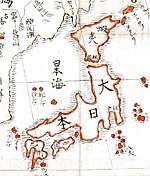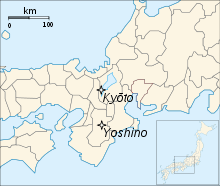Kōkoku
| History of Japan |
|---|
 |
Kōkoku (興国) was a Japanese era of the Southern Court during the Era of Northern and Southern Courts after Engen and before Shōhei, lasting from April 1340 to December 1346.[1] The emperor in Kyoto was Emperor Kōmyō (光明天皇 Kōmyō-tennō).[2] Go-Kōgon's Southern Court rival in Yoshino during this time-frame was Emperor Go-Murakami (後村上天皇 Go-Murakami-tennō).
Nanboku-chō overview
During the Meiji period, an Imperial decree dated March 3, 1911 established that the legitimate reigning monarchs of this period were the direct descendants of Emperor Go-Daigo through Emperor Go-Murakami, whose Southern Court (南朝 nanchō) had been established in exile in Yoshino, near Nara.[3]
Until the end of the Edo period, the militarily superior pretender-Emperors supported by the Ashikaga shogunate had been mistakenly incorporated in Imperial chronologies despite the undisputed fact that the Imperial Regalia were not in their possession.[3]
This illegitimate Northern Court (北朝 hokuchō) had been established in Kyoto by Ashikaga Takauji.[3]
Change of era
Events of the Kōkoku Era
- 1342 (Kōtoku 3): Ichijō Tsunemichi loses his position as kampaku; and he is replaced by Kujō Michinori.[4]
- 1342 (Kōtoku 3): Minamoto no Nagamichi (源長通) is removed from his position as daijō daijin.[4]
- 1342 (Kōtoku 3): Kujō Michinori is replaced by Takatsukasa Morohira, who was formerly udaijin.[4]
- 1342 (Kōtoku 3): Fujiwara no Kiyoko dies. She was the daughter of Usesugi Yorishige and the mother of Ashikaga Takauji.[4]
- 1343 (Kōtoku 4): Nijō Yoshimoto, the author of Masukagami, was promoted from the court position of nadaijin to udaijin; and in due course, the udaijin was promoted to sadaijin. The dainagon was promoted to nadaijin.[4]
- 1344 (Kōtoku 4): Shogun Takauji offered prayers at Iwashimizu Hachiman-gū.[4]
Notes
- ↑ Nussbaum, Louis-Frédéric. (2005). "Kōkoku" in Japan encyclopedia, p. 549; n.b., Louis-Frédéric is pseudonym of Louis-Frédéric Nussbaum, see Deutsche Nationalbibliothek Authority File Archived 2012-05-24 at Archive.is.
- ↑ Titsingh, Isaac. (1834). Annales des empereurs du japon, pp. 294-297; Nussbaum, p. 541.
- 1 2 3 Thomas, Julia Adeney. (2001). Reconfiguring modernity: concepts of nature in Japanese political ideology, p. 199 n57, citing Mehl, Margaret. (1997). History and the State in Nineteenth-Century Japan. p. 140-147.
- 1 2 3 4 5 6 Titsingh, p. 297.
References
- Mehl, Margaret. (1997). History and the State in Nineteenth-Century Japan. New York: St Martin's Press. ISBN 978-0-312-21160-8; OCLC 419870136
- Nussbaum, Louis Frédéric and Käthe Roth. (2005). Japan Encyclopedia. Cambridge: Harvard University Press. ISBN 978-0-674-01753-5; OCLC 48943301
- Thomas, Julia Adeney. (2001). Reconfiguring Modernity: Concepts of Nature in Japanese Political Ideology. Berkeley: University of California Press. ISBN 978-0-520-22854-2; OCLC 47916285
- Titsingh, Isaac. (1834). Nihon Odai Ichiran; ou, Annales des empereurs du Japon. Paris: Royal Asiatic Society, Oriental Translation Fund of Great Britain and Ireland. OCLC 5850691
External links
- National Diet Library, "The Japanese Calendar" -- historical overview plus illustrative images from library's collection
| Preceded by Engen |
Era or nengō Kōkoku 1340–1346 |
Succeeded by Shōhei |
